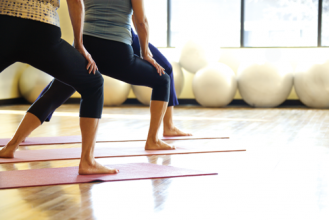If you’re coming back to exercise after a heart issue, or just want to begin a gentle, heart heathy form of exercise, yoga may be the answer. Studies show it lowers heart disease risk as much as regular exercise, such as walking.
Yoga is a physical practice that emphasizes movement, breath, focus and meditation. What’s more, simple breathing as used in yoga (in through the nose and out through the nose) slows heart rate, lowers blood pressure, relieves stress and anxiety and is therapeutic for heart health.
Everyone over fifty should get a doctor’s clearance before doing yoga, or any other exercise program. It’s also important to let the yoga teacher know if you have any heart or health condition.
“A strong heart requires a good flow of oxygen and blood, good circulation and no inflammation,” says Lynn Anderson, Ph.D., a natural health expert, faculty member to the American Council on Exercise and Prime of Life Yoga instructor for those over 50.
“Yoga builds cardiovascular health, increases lung capacity and improves respiratory function and heart rate. It also boosts blood circulation, builds muscle and decreases inflammation,” says Anderson.
 In fact, yoga poses can reduce the amount of work placed on the heart, improve circulation, improve the flow of oxygen and blood throughout the body, and reduce anxiety, stress and mild depression. “It is inflammation, poor circulation, stress and the lack of oxygen that lead to heart and other health issues,” says Anderson.
In fact, yoga poses can reduce the amount of work placed on the heart, improve circulation, improve the flow of oxygen and blood throughout the body, and reduce anxiety, stress and mild depression. “It is inflammation, poor circulation, stress and the lack of oxygen that lead to heart and other health issues,” says Anderson.
Get Going
Start with a class for beginners, even if you’re coming back to yoga after an illness. Hatha and Iyengar are good choices. Anderson says certain poses like easy inversions (where you put your legs against the wall, flatten your back against it and breathe) are fine. But things like bending forward are sometimes difficult, especially if you are winded or have blood pressure problems.
Rather, Anderson suggests focusing on simple breathing techniques while opening the chest in poses like bound angle pose or head of the knee pose. Obviously you’ll want a teacher who can modify poses for your health and skill level.
For example, if you’re doing a plank, which is really good for strengthening the core, some people find it difficult, so a modified plank drops your knees yet still provides the core strengthening benefits of the plank pose.
“Sun salutations are somewhat aerobic and are excellent for heart health and strength. They slightly increase heart rate, thus improving cardiovascular functioning,” says Anderson.
What to Consider
It’s important to remember that medication can affect you in different ways. You might become light headed or dizzy or need to eat lightly or abstain from eating before a class. Trial and error is the best way to find out what works for you.
Ultimately, you should aim to exercise at least 30 minutes daily and incorporate yoga two days per week.
Yoga walking can also be a great form of yoga for improving cardiovascular health, as well as reducing stress. Either with a group or solo, take a few quiet yoga breaths before heading out on a 30 minute silent walk. The idea is to be very Zen and when you’re walking, walk. “Oftentimes when we’re walking were thinking about kids, problems and work and that’s not walking, it’s stressing,” says Anderson. The point is to pay attention to your movement, quiet your mind and stay with nature.
When you focus on breathing, you not only quiet the mind but while that’s happening, your body chemistry changes as oxygen balances the parasympathetic nervous system, which helps lower blood pressure, bring down heart rate, relax muscles and drive oxygen throughout the body. “The more oxygen you drive through the body, the more it feeds the cells and the healthier you get,” says Anderson.
Sitting quietly, breathing and getting in touch with the quietude of your mind reminds us that the most important thing in your life is your health–and yoga is a great way to focus on health.